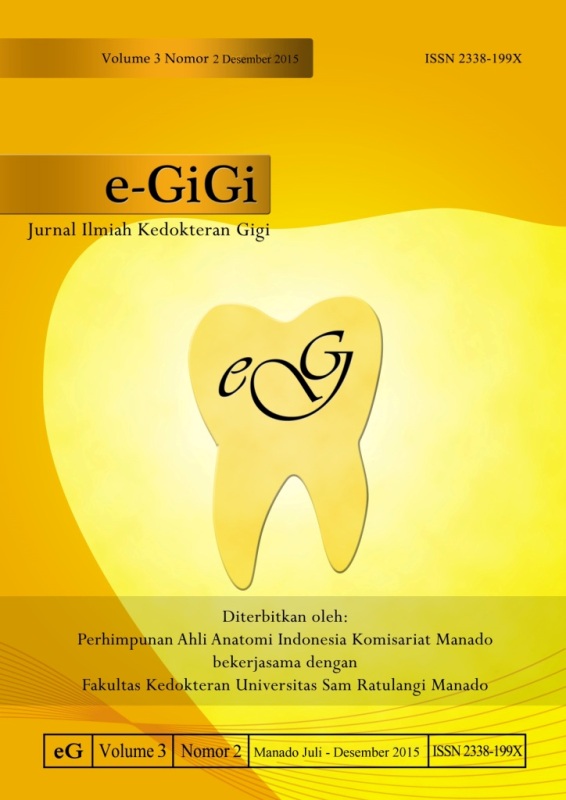DAYA HAMBAT EKSTRAK KULIT MANGGIS (Garcinia Mangostana L.) TERHADAP Streptococcus mutans
DOI:
https://doi.org/10.35790/eg.3.2.2015.8824Abstract
Abstract: Mangosteen fruit which in Latin is called Garcinia mangostana Linn identical with the nickname queen tropical fruit (Queen of tropical fruit) is a plant that can be utilized all its parts, including the skin of the fruit. Dental caries is an oral disease that often occurs. Streptococcus mutans is one of the causes of dental caries. This study is an experimental laboratory, using pure experimental designs (true experimental design) with a post-test only research design control design conducted in the Laboratory of Microbiology General Hospital Prof. DR. R.D. Kandou Manado in December 2014-May 2015 with research subjects using Streptoccocus mutans bacteria and as a research sample taken mangosteen peel extract (Garcinia mangostana L) were extracted using maceration method by ethanol 90%. The result showed the average broad zones of inhibition of mangosteen peel extract against Streptococcus mutans amounted at 669.42 mm2. Results of statistical calculations with independent t-test test is known that there were significant differences between groups of mangosteen peel extract and the control group (P <0.05). From this study it can be concluded that the mangosteen peel extract (Garcinia mangostana L.) has an antibacterial effect in inhibiting the growth of Streptococcus mutans bacteria. Wide zone of inhibition of mangosteen peel extract (Garcinia mangostana L.) is smaller than the broad zone of inhibition of antibiotics.
Keywords: Skin Extract Mangosteen (Garcinia mangostana L.), Streptoccocus mutans
Abstrak: Buah manggis yang dalam bahasa latin disebut Garcinia mangostana Linn yang identik dengan julukan ratu buah tropis (Queen of tropical fruit) merupakan tanaman yang seluruh bagiannya dapat dimanfaatkan, termasuk kulit buahnya. Karies gigi merupakan penyakit gigi dan mulut yang sering terjadi. Streptococcus mutans merupakan salah satu penyebab karies gigi. Penelitian ini merupakan penelitian eksperimental laboratorium, menggunakan rancangan eksperimental murni (true experimental design) dengan rancangan penelitian post test only control design yang dilakukan di Laboratorium Mikrobiologi Rumah Sakit Umum Prof. DR. R. D. Kandou Manado pada bulan Desember 2014–Mei 2015 dengan subjek penelitian mengunakan bakteri Streptoccocus mutans dan sebagai sampel penelitian diambil ektrak kulit manggis (Garcinia mangostana L) yang diekstraks menggunakan metode maserasi dengan pelarut etanol 90%. Hasil penelitian didapatkan rata-rata luas zona hambat ekstrak kulit manggis terhadap Streptococcus mutans sebesar sebesar 669.42 mm2. Hasil perhitungan statistik dengan uji independent t-test diketahui terdapat perbedaan yang bermakna antara kelompok ekstrak kulit manggis dan kelompok kontrol (P < 0.05). Dari penelitian ini dapat disimpulkan bahwa ekstrak kulit manggis (Garcinia mangostana L.) memiliki efek antibakteri dalam menghambat pertumbuhan bakteri Streptococcus mutans. Luas zona hambat dari ekstrak kulit manggis (Garcinia mangostana L.) lebih kecil dibandingkan dengan luas zona hambat dari antibiotik.
Kata kunci: Ektrak Kulit Manggis (Garcinia mangostana L.), Streptoccocus mutans
Downloads
How to Cite
Issue
Section
License
COPYRIGHT
Authors who publish with this journal agree to the following terms:
Authors hold their copyright and grant this journal the privilege of first publication, with the work simultaneously licensed under a Creative Commons Attribution License that permits others to impart the work with an acknowledgment of the work's origin and initial publication by this journal.
Authors can enter into separate or additional contractual arrangements for the non-exclusive distribution of the journal's published version of the work (for example, post it to an institutional repository or publish it in a book), with an acknowledgment of its underlying publication in this journal.
Authors are permitted and encouraged to post their work online (for example, in institutional repositories or on their website) as it can lead to productive exchanges, as well as earlier and greater citation of the published work (See The Effect of Open Access).






